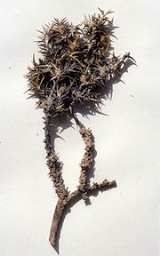
Halothamnus beckettii
Encyclopedia
Halothamnus beckettii is a species of the plant genus Halothamnus
, that is now included into the family Amaranthaceae
, (formerly Chenopodiaceae
). It is the only member of the section H. sect.Pungentifolia, which differs from H. sect. Halothamnus by hard leaves with spiny apex.
Halothamnus
Halothamnus is a genus of the former Chenopodiaceae that is now included into the family Amaranthaceae. The scientific name means saltbush, from the Greek ἅλς "salt" and θαμνος "bush"...
, that is now included into the family Amaranthaceae
Amaranthaceae
The flowering plant family Amaranthaceae, the Amaranth family, contains about 176 genera and 2,400 species.- Description :Most of these species are herbs or subshrubs; very few are trees or climbers. Some species are succulent....
, (formerly Chenopodiaceae
Chenopodiaceae
Chenopodiaceae were a family of flowering plants, also called the Goosefoot Family. They are now included within family Amaranthaceae. The vast majority of Chenopods are weeds, and many are salt and drought tolerant. A few food crops also belong to the family: spinach, beets, chard, quinoa, and...
). It is the only member of the section H. sect.Pungentifolia, which differs from H. sect. Halothamnus by hard leaves with spiny apex.

